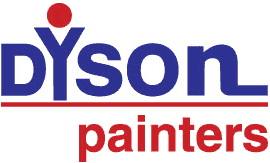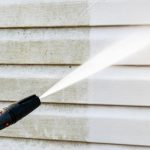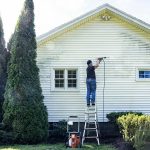Maintaining the interiors and exteriors of your home is not just about aesthetics. It’s also about preserving its structural integrity and value. High-pressure cleaning can be an effective tool for achieving this goal, but its potential pitfalls should not be underestimated. As a premier house painting and cleaning service in Hobart, we understand the significance of a well-maintained home.
This guide is designed to help you learn about 20 pressure-washing mistakes that homeowners should steer clear of, ensuring that your house stays in pristine condition for years to come.
20 High-Pressure Cleaning Mistakes to Avoid for Your Home
1. Washing in the Wrong Sequence
Pressure washing is a systematic process that requires a well-thought-out plan. Commencing the cleaning process without considering the sequence of tasks can lead to water and grime trickling onto surfaces that have already been cleaned. This can render your efforts futile and necessitate redoing certain areas. To circumvent this, begin by tackling the highest surfaces first, such as the roof, and work your way downwards. This ensures that dirt and water flow naturally away from surfaces that have already been cleaned.
2. Lack of Knowledge
While high-pressure cleaning might appear straightforward, it’s more nuanced than it seems. Insufficient knowledge about the appropriate pressure settings, nozzle types, and cleaning agents can have unintended consequences. This includes surface damage, poor cleaning results, or even personal injury. Before embarking on a pressure washing project, take the time to educate yourself about the specific requirements for different surfaces and stains. This knowledge will empower you to use your pressure washer effectively and safely.
3. Excessive Pressure
The allure of a quick and forceful cleaning might prompt you to crank up the pressure, but this can prove detrimental to your home’s surfaces. Excessive pressure can strip away paint, gouge wood, and even force water underneath siding or shingles. Always begin with the lowest pressure setting and gradually increase it as needed. This cautious approach guarantees that you achieve effective cleaning without causing damage.
4. Breaking Windows
One of the most common and potentially costly mistakes in high-pressure cleaning is directing high-pressure water towards windows. The intense force can lead to shattered glass and result in additional expenses for window replacements. When cleaning window glasses, opt for lower pressure settings and wider fan nozzles. Alternatively, consider using a squeegee or a specialised window cleaning tool to avoid the risk altogether.
5. Hiring the Wrong Company
For those who are unsure about handling a pressure washer themselves, hiring a professional high-pressure cleaning service in Hobart is a prudent choice. However, the quality of workmanship varies among service providers. Entrusting your home to an inexperienced or unreliable company can lead to subpar results, potential damage, and unwarranted expenses. Research and select a reputable company with a track record of delivering exceptional pressure washing services.
6. Using Only Water
While water is the fundamental component of pressure washing, it might not suffice to tackle all types of stains. Grease, oil, mould, and mildew often require specialised cleaning solutions to achieve optimal results. Utilise appropriate cleaning agents for various surfaces and stains, enhancing the efficiency of the washing efforts and preventing future growth.
7. Not Protecting Landscaping
The potent force of a pressure washer can unintentionally dislodge mulch, damage plants, and erode soil. It’s imperative to safeguard your landscape by covering delicate plants and shrubs with plastic sheeting before initiating the cleaning process. This simple precautionary step prevents inadvertent harm to your outdoor greenery.
8. Power-Washing Painted Surfaces
Using excessive pressure on painted surfaces is a recipe for disaster. The force can strip away the paint, leaving your surfaces vulnerable to the elements. To safeguard painted areas while effectively removing dirt, adjust the pressure settings and employ wider fan nozzles. This approach ensures that you clean painted surfaces without compromising their integrity.
9. Power-Washing Mould-Prone Surfaces
While high-pressure cleaning is effective at removing mould, directly blasting mould-prone surfaces can scatter the spores into the air, potentially exacerbating the problem. To mitigate this, use specialised mould cleaners in conjunction with a gentler pressure wash. This combination not only eliminates existing mould but also reduces the likelihood of spore dispersion.
10. Using Hot Water
Hot water can be an asset when tackling greasy or oily surfaces. However, exercise caution when applying it. Delicate materials like vinyl siding can warp under high temperatures, leading to unsightly deformations. Consider the material and type of surface you’re cleaning before deciding to use hot water.
11. Not Being Familiar with Your Equipment
Before embarking on any pressure washing endeavour, familiarise yourself with the equipment. Read the user manual thoroughly, acquaint yourself with the different nozzle options, and practice in an inconspicuous area to understand the power of the machine. This knowledge empowers you to utilise your pressure washer effectively and confidently.
12. Storing a Pressure Washer with Water in It
Leaving water in your high-pressure cleaning machine between uses can lead to internal corrosion or even freezing during cold weather. To prolong the life of your machine, always empty the water and store it properly in a dry and cool location.
13. Forgetting to Angle the Spray
A common oversight is holding the washer wand perpendicular to the surface being cleaned. This can force water into cracks, seams, or beneath surfaces. To prevent this, angle the spray slightly downward, allowing water to run off harmlessly without infiltrating vulnerable areas.
14. Not Using Safety Equipment
Pressure washing involves high-pressure water that can cause injuries if it comes into contact with your skin or eyes. Prioritise safety by wearing protective goggles, suitable footwear, and gloves. These precautions shield you from potential harm and enhance your overall safety while working with the equipment.
15. Using the Wrong Nozzle
High-pressure cleaning equipment comes with various nozzle options, each producing distinct spray patterns and pressures. Choosing the wrong nozzle for a specific task can result in damage to surfaces or inefficient cleaning. Thus, it is wise to hire professionals to achieve a smooth and flawless job.
16. Spraying Upward Against Siding
Directing the pressure washer spray upward against the siding, shingles, or other surfaces can force water behind them, leading to moisture-related problems and mould growth. To avoid such complications, always direct the spray downward, following the natural flow of water.
17. Using a Gas-Powered Pressure Washer Indoors
Gas-powered pressure washers emit harmful fumes, rendering them unsuitable for indoor use. Opt for electric pressure washers when cleaning indoor spaces to ensure air quality and personal safety.
18. Not Protecting the Surrounding Area
High-pressure cleaning can generate a considerable mess. Before you commence cleaning, take measures to safeguard your outdoor furniture, cover electrical outlets, and shield items that may be vulnerable to water or cleaning agents.
19. Not Allowing Surfaces to Dry Completely
After pressure washing, it’s crucial to allow surfaces to dry thoroughly before applying any coatings like paint, stain, or sealant. Painting over damp surfaces can lead to poor adhesion and premature peeling, undermining the durability of your efforts.
20. Not Having a Plan
Randomly attacking your cleaning tasks without a clear strategy can result in an incomplete job and missed spots. To ensure thorough and consistent results, divide your cleaning projects into manageable sections and follow a systematic approach.
FAQs About High-Pressure Cleaning Your Home
1. Is pressure washing safe for all types of surfaces?
While high-pressure cleaning can effectively clean various surfaces, it’s essential to adjust the pressure settings based on the material. Delicate surfaces like wood and vinyl require lower pressure to avoid damage, while concrete and brick can tolerate higher pressure levels.
2. Can I pressure wash my own home, or should I hire professionals?
You can certainly pressure wash your own home, but it’s vital to have proper knowledge about equipment, techniques, and safety measures. If you’re unsure, it’s advisable to hire professionals who have the expertise to deliver optimal results without risking damage.
3. Will high-pressure cleaning remove all stains and dirt?
Pressure washing can remove many stains and dirt, but some stubborn ones might require additional treatments or multiple passes. For challenging stains like oil or rust, you may need to use specialised cleaning agents alongside pressure cleaning.
4. How often should I pressure wash my home’s exterior?
The frequency of pressure washing depends on factors like climate, local environment, and the type of surfaces. Generally, an annual or biennial pressure wash is recommended to maintain your home’s appearance and prevent buildup.
5. Can I use pressure washing to prepare surfaces for painting?
Yes, high-pressure cleaning can effectively prepare surfaces for painting by removing dirt, grime, and loose paint. However, ensure the surface is completely dry before applying paint to achieve proper adhesion.
6. Is renting a pressure washer a good idea?
Renting a pressure washer can be cost-effective for occasional use. However, ensure you receive proper instructions on usage and maintenance from the rental provider to avoid mistakes that could damage your home or the equipment.
Remember, if you’re unsure about any aspect of pressure washing, consulting with professionals can provide you with the guidance you need to achieve the best results while safeguarding your home’s integrity. Read here to learn more about their benefits.
Get Professional High-Pressure Cleaning in Hobart!
When it comes to maintaining the pristine appearance of your home, the expertise of professional high-pressure cleaning services in Hobart can make all the difference. At Dyson Painters, we boast over 50 years of experience in achieving high-quality paint jobs, including other essential services such as high-pressure cleaning.
Avoid the hassle and potential mishaps of DIY pressure washing by entrusting your home to experienced professionals. Our skilled team knows the ins and outs of pressure washing, ensuring that every surface is treated with care and precision.
Contact us at 0420-213-214 or email us at dysonpainters@bigpond.com to learn more about our expertise. Experience the convenience and excellence of our professional services.
Also Read:
What to Expect From High-Pressure Cleaning?
Benefits of Pressure Washing Your Property
Everything You Need to Know About Pressure Washing
Which Places Require High-Pressure Cleaning?





